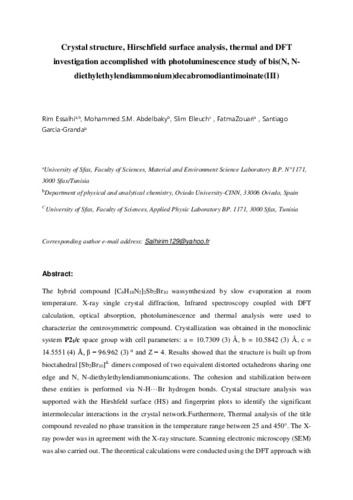Crystal structure, Hirschfield surface analysis, thermal and DFT investigation accomplished with photoluminescence study of bis(N, N-diethylethylendiammonium)decabromodiantimoinate(III)
Autor(es) y otros:
Palabra(s) clave:
X-ray diffraction
Hirschfeld surfaces
DFT calculations
thermal analysis
photoluminescence
Fecha de publicación:
Versión del editor:
Citación:
Descripción física:
Resumen:
The hybrid compound [C6H18N2]2Sb2Br10 was synthesized by slow evaporation at room temperature. X-ray single crystal diffraction, Infrared spectroscopy coupled with DFT calculation, optical absorption, photoluminescence and thermal analysis were used to characterize the centrosymmetric compound. Crystallization was obtained in the monoclinic system P21/c space group with cell parameters: a = 10.7309 (3) Å, b = 10.5842 (3) Å, c = 14.5551 (4) Å, β = 96.962 (3) ° and Z = 4. Results showed that the structure is built up from bioctahedral [Sb2Br10]4- dimers composed of two equivalent distorted octahedrons sharing one edge and N, N-diethylethylendiammoniumcations. The cohesion and stabilization between these entities is performed via N-H···Br hydrogen bonds. Crystal structure analysis was supported with the Hirshfeld surface (HS) and fingerprint plots to identify the significant intermolecular interactions in the crystal network.Furthermore, Thermal analysis of the title compound revealed no phase transition in the temperature range between 25 and 450°. The X-ray powder was in agreement with the X-ray structure. Scanning electronic microscopy (SEM) was also carried out. The theoretical calculations were conducted using the DFT approach with the B3LYP/LanL2DZ basis set to depict the vibrational IR spectrum of the investigated compound in its ground state. A satisfactory agreement was found between the calculated and experimental results for the structural parameters and the vibrational properties. Moreover, Photoluminescence measurements showed a strong emission line at 3.64eV, the unaided-eye detectable blue luminescence emission came from the excitonic transition in the Sb2Br10 anions.
The hybrid compound [C6H18N2]2Sb2Br10 was synthesized by slow evaporation at room temperature. X-ray single crystal diffraction, Infrared spectroscopy coupled with DFT calculation, optical absorption, photoluminescence and thermal analysis were used to characterize the centrosymmetric compound. Crystallization was obtained in the monoclinic system P21/c space group with cell parameters: a = 10.7309 (3) Å, b = 10.5842 (3) Å, c = 14.5551 (4) Å, β = 96.962 (3) ° and Z = 4. Results showed that the structure is built up from bioctahedral [Sb2Br10]4- dimers composed of two equivalent distorted octahedrons sharing one edge and N, N-diethylethylendiammoniumcations. The cohesion and stabilization between these entities is performed via N-H···Br hydrogen bonds. Crystal structure analysis was supported with the Hirshfeld surface (HS) and fingerprint plots to identify the significant intermolecular interactions in the crystal network.Furthermore, Thermal analysis of the title compound revealed no phase transition in the temperature range between 25 and 450°. The X-ray powder was in agreement with the X-ray structure. Scanning electronic microscopy (SEM) was also carried out. The theoretical calculations were conducted using the DFT approach with the B3LYP/LanL2DZ basis set to depict the vibrational IR spectrum of the investigated compound in its ground state. A satisfactory agreement was found between the calculated and experimental results for the structural parameters and the vibrational properties. Moreover, Photoluminescence measurements showed a strong emission line at 3.64eV, the unaided-eye detectable blue luminescence emission came from the excitonic transition in the Sb2Br10 anions.
Patrocinado por:
We acknowledge the financial support from the Ministry of Higher Education and Scientific Research of Tunisia, Spanish Ministerio de Economía y Competitividad (MAT2016-78155-C2-1-R) and Gobierno del Principado de Asturias (GRUPIN-IDI/2018/170).
Colecciones
- Artículos [36140]
- Investigaciones y Documentos OpenAIRE [7870]
- Química Física y Analítica [597]
Ficheros en el ítem





